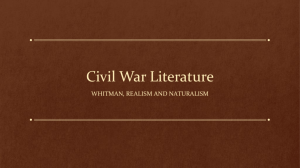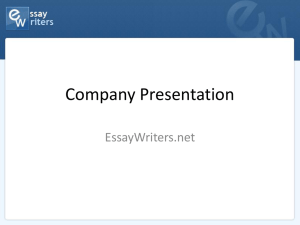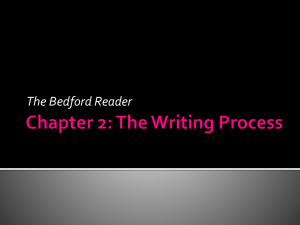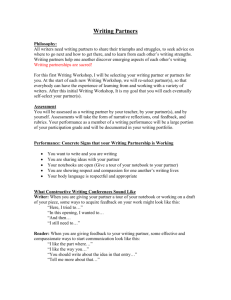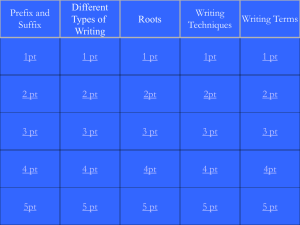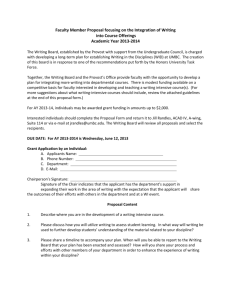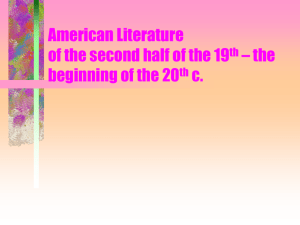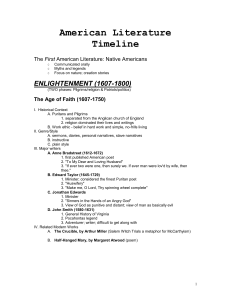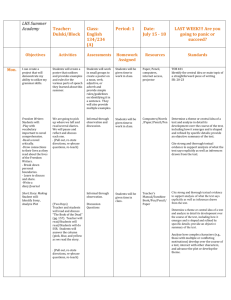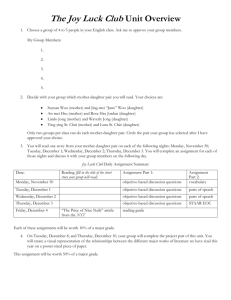English/Language Arts Review
advertisement
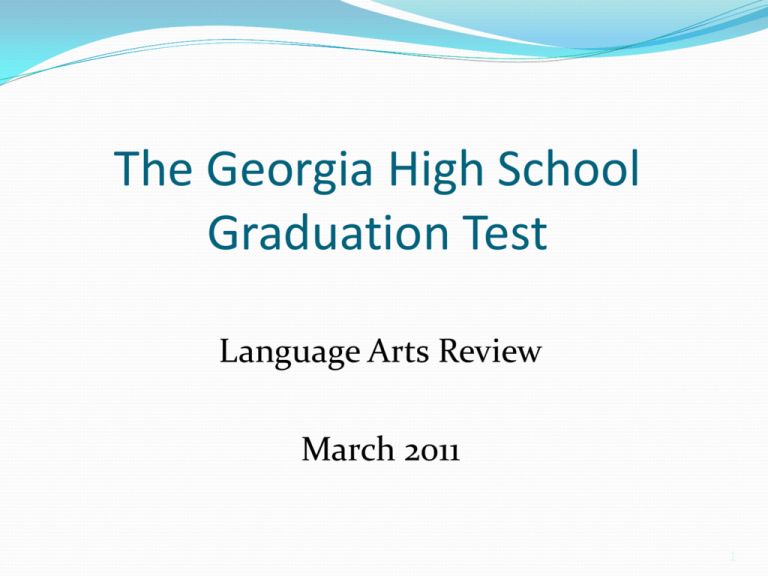
The Georgia High School Graduation Test Language Arts Review March 2011 1 Literary Terms Antagonist Climax Conflict - man versus man - man versus nature - man versus himself Dialect Dialogue Irony - dramatic - situational - verbal Plot Point-of-View Protagonist Theme Setting 2 Literary Terms (cont.) Author’s purpose Symbol Literal vs. Figurative Language Universal theme Foreshadowing Tone In medias res Characterization Flashback The Basic Points-of-View 1st Person – told from a ‘personal reflection,’ - a character in the story tells the story 3rd Person Limited – focuses on the thoughts of one character 3rd Person Omniscient – the author lets us see into the minds of the characters 4 Poetry Terms Alliteration Oxymoron Assonance Paradox Hyperbole Personification Imagery Simile Metaphor Theme Mood Tone Onomatopoeia 5 Pattern of Rhyme (Rhyme Scheme) “The Road Not Taken” by Robert Frost Two roads diverged in a yellow wood, (a) And sorry I could not travel both (b) And be one traveler, long I stood (a) And looked down one as far as I could (a) To where it bent in the undergrowth (b) Fact and Opinion FACT OPINION A true statement that can be proven through observation, research, or statistics. A statement of judgment or personal belief. It may or may not be true. The word “I” is often used. 7 Slang and Colloquial English Slang – Very informal language that enjoys brief popularity then becomes obsolete. Colloquial English – Refers to words that are appropriate in dialogue and informal writing but inappropriate in formal writing. 8 Inappropriate and Standard American English Inappropriate English/Informal – Contains grammar and usage that does not follow the standard rules of English. Standard American English/Formal – The English that is most widely accepted in the United States. It is considered the language of educated people. 9 New Vocabulary main idea = theme writing focus = genre research venue (i.e., library, survey, interview) works cited = bibliography thesis statement = controlling idea, focus statement 10 PERIODS OF AMERICAN LITERATURE 11 Native-American Era Characteristics Focus on the common origin of all things, tribal traditions, and respect for all nature. Types of Literature mostly oral ceremonial songs prayers historical narratives poems 12 Puritan/Planter Age Characteristics God’s grace saves us. Everything is done for the glorification of God. Plainness in all things. Writers and Works Anne Bradstreet “To My Dear and Loving Husband” Edward Taylor “Huswifery” Jonathan Edwards “Sinners in the Hands of An Angry God” 13 The Revolutionary Period (Age of Reason) Characteristics High regard for reasoning Strong belief in human progress Little interest in religion Freedom from restrictive laws and governments Writers and Works Phyllis Wheatley “To His Excellency, George Washington” “An Hymn to the Evening” Thomas Paine from “Crisis, Number 1” Thomas Jefferson “Declaration of Independence” Benjamin Franklin from The Autobiography 14 The Romantic Age Characteristics High regard for inner feelings and emotions Nature is inspirational. Interest in the past Use of language of the common people Writers and Works The Fireside Poets Longfellow, Bryant, Holmes, Lowell, Whittier Washington Irving “The Devil and Tom Walker” Nathaniel Hawthorne “The Minister’s Black Veil” Edgar Allan Poe “The Raven” Herman Melville Moby Dick 15 Transcendentalism Characteristics Truth is found in the physical world. Happiness comes through individualism and self-reliance. Nature is revered. Writers and Works Walt Whitman “Leaves of Grass” Emily Dickinson “I Heard a Fly Buzz – When I Died” “Because I Could Not Stop For Death” Ralph Waldo Emerson from “Nature” from “Self Reliance” Henry David Thoreau from Walden 16 Realism and Naturalism Characteristics Expression of life as it is actually lived Factual descriptions of ordinary characters Subject matter often consists of factories, slums, criminals, and social outcasts. Heredity, environment, and economics determine one’s destiny. Human beings are at the mercy of brutal forces beyond their control. 17 Realism and Naturalism (cont.) Writers and Works Bret Harte “The Outcasts of Poker Flat” Jack London “To Build a Fire” Mark Twain “The Notorious Jumping Frog of Calaveras County” The Adventures of Huckleberry Finn Frederick Douglass from My Bondage and My Freedom Kate Chopin “The Story of An Hour” Stephen Crane “An Episode of War” 18 The Modern Age (1914-1945) Characteristics Loss of idealism due to Opposition to dehumanizing trends in modern life Dignity of people in spite of great challenges Search for new hope war, industrialization, and political changes Experimental forms of poetry Raised awareness of Black culture and concerns 19 The Modern Age (cont.) Writers and Works Eudora Welty “A Worn Path” Ernest Hemingway “In Another Country” Katherine Ann Porter “The Jilting of Granny Weatherall” F. Scott Fitzgerald The Great Gatsby William Faulkner “A Race at Morning” Flannery O’Connor “The Life You Save May Be Your Own” John Steinbeck Of Mice and Men Alice Walker The Color Purple Arthur Miller The Crucible 20 The Modern Age The Harlem Renaissance Zora Neale Hurston from Dust Tracks on a Road Their Eyes Were Watching God Langston Hughes “Dream Variations” “Dream Deferred” Countee Cullen from “The Dark Tower” 21 Post-Modernism 1945 - Present 22

